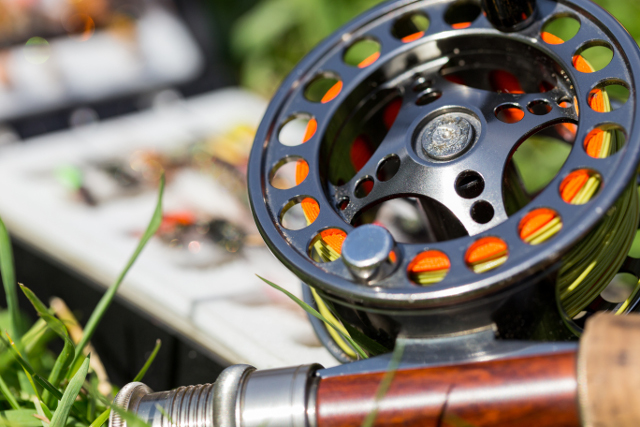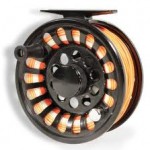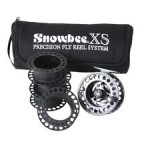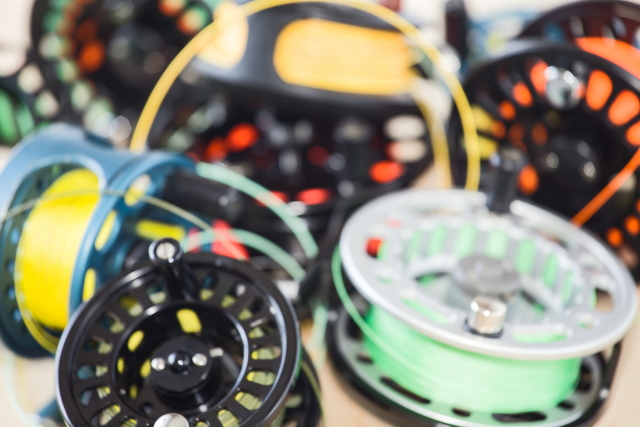| Disclosure: Just to be open and honest the buttons and links you click on in the website will in most cases take you to another website where you can purchase the products I am reviewing. As an Amazon Associate I earn from qualifying purchases. |
Fly Fishing Reels Explained – More than a Fly Line Container?

Fly fishing reels explained will show you that the reel is more than a container for your fly line to keep it off the ground when playing a fish. Unlike conventional bait rods the line will have to be retrieved in by hand to entice the trout to take your fly and as this happens the line will be increasingly lying at your feet unless you are using a fly line tray.
This is not so bad when you are on a sandy beach or clay bank side but if there is a lot of undergrowth then the line will get caught up on the vegetation and when that trout of a lifetime decides to take your fly you don’t want to be trying to pull the line free to play it in. Many a prize trout was lost this way believe me.
The reel is therefore to reel up the line before you try to play the trout. This can be done  with ease with a bit of practice as you hold the line tight to keep tension on the trout as you reel up the line with your other hand. This may sound difficult but it is not.
with ease with a bit of practice as you hold the line tight to keep tension on the trout as you reel up the line with your other hand. This may sound difficult but it is not.
You can play a trout without reeling in first but this is only advisable when on a snag-free environment, even sitting in a boat is not the place as oars, bags, your partner can all get tangled up with your fly line very easily.
Once you have the line on the reel you can let the trout fight and take line and reel it back on with the knowledge that you are free to move in any direction it decides to go.
Quick Post Navigation
So what type of fly fishing reel are you after?
To begin with, you will have decided on which fly rod you need and on the handle of that rod, you will have a line rating usually in the range of 5, 6 or 7 for trout rods. This is when it is important to match the fly line and the fly fishing reel to the rod so that everything is matched and balanced. When it is balanced it makes the task of fly casting so much easier and the rod will load and form nice tight loops.
Manufacturers of fly fishing reels have come up with a system of covering a few sizes so your reel can be used over various rod sizes. For instance, there are 4-5, 5-6, 6-7, or 7-8 and sometimes 6-8, 5-7 covering three sizes of line.
These are only recommendations by the manufacturers as the overall size of the reel will depend on;
2 How much backing line you wish to put on.
For example, the Redington Rise 7-8 fly reel is designed for a weight forward 8 line plus 200yds of size 20lb backing.
Lightweight fly reels are the way to go.
Don’t worry too much about this for now just look at the line rating on your rod let’s say it’s a 7 then we want to get a 6-7 or a 7-8 . These will be fairly similar in size one just slightly bigger than the other and hence slightly heavier.
The difference may be hard to notice in the hand but when fishing for an eight hour day we want our line, fly fishing rod and reel to be as light as we possibly can. Having lightweight tackle allows you to fly fish for so much longer without fatigue.
Like all things in this world when they make it better they put the price up and usually anything that is very light will have a large price tag so bear this in mind when deciding.
As you are a beginner I would try to get a setup as cheaply as possible as you can always get upgraded as your skills improve. Consider this if you go out and pay £500 on a new set up try for a few weeks then decide fly fishing is not for you it will be an expensive trial.
You could sell it off second hand but you will be lucky to get half of what it’s worth. Also as a beginner, your skills will not be as sharp as required and you will most likely bang it against something or have some sort of accident leaving you with a four piece rod when it came to you as three.

The other thing to mention is some fly fishing reels come with spare spools while others don’t. As a beginner you will want a full floating fly line which we will cover in the next post but as you progress you will want various density lines to cover different situations and fly fishing types. It is, therefore, cost-effective to purchase a reel with spare spools. There are in some cases cassette fly fishing reels cartridge reels that allow for the inner section to be removed before placing in another in some cases these cartridge setups may have 4 or 5 spools.
Other aspects of the fly reel to consider
We have mentioned the size which is overall the main priority but there are other features that can improve your experience on the water.
- Reel Arbor
- Drag System
- Anti-Corrosive
What is the reel arbor?
The arbor of a fly reel is the depth of the center spindle from the edge. A classic fly reel of past generations would have a small arbor meaning the fly line would be wound tightly around the spindle causing line coil memory when trying to get the line out on the water after a period of time lying on the reel.
Nowadays reels have normally a larger arbor meaning the depth of the spool is shallower giving the line less memory coil and the ability of the angler to wind the line quicker as each turn of the reel brings in more line. There is also med arbor reels allowing the best of both, the ability to wind quickly but also hold a lot of line.
Some manufacturers now arbor their reels with certain grooves to help in line lay down and grip especially when playing larger species and I’m sure as technology improves more variations on the arbor will be available.
What kind of reel drag do you need?
There are two main options in drag type although many variations on how that drag is applied. The two types are sealed drag and unsealed.
Sealed is the more expensive of the two options as these were developed to keep dirt and grim out of the drag system to make sure of constant grip and pressure throughout the lifetime of the reel. More and more anglers are taking fly fishing gear to the sea and as you may be aware saltwater plays havvoc with gear and the drag sytem on a fly reel is a prime example of a place for corrosion to penetrate. Having a sealed drag means saltwaer cannot get into the system and corrode it. Saying that it is important that anglers make sure to rinse off their reels and gear with freshwater afterwards to keep it in tip top shape.
The lesser of the two drag systmes is simple non sealed which means tis open to dirt and grim getting into the mechanism. It is important with these reels to perform maintainance at peak times and during the off season to make sure there is not a build up of grit and plenty of grease keeping the system as good as possible.
On drag systems their are many ways for the drag to actually work. Many use discs of varing sizes and abrasion which rub together to cause pressure or drag on the fish as it runs. If non sealed dirt inbetween these disc can cause them to slip and stutter casuing the fish to be jerked and possibly lost. Other drag system use conical disc to apply the brakes. Two similary shaped cones fit into each other to provide a small drag system that can be sealed making it grit free and pretty much maintainance free. As you can imagine these sealed drag systems come at an extra cost but well worth the investment if intending to fish in the saltwater.
Anti-corrosion what to look out for in fly reels.
Fly reels need to be lighweight and to produce this most manufacturers opt for aluminum which is very tough and strong. To further give it long life they anodize the surface of the reel with electricity and chemicals which can produce not only tough surfaces but colors to further enhnace the beauty of the reel. Some companies have taking this process to a new level provide the angler with reels that not only have oustanding performance but are works or art.
For more information check out this other post on trout fly fishing reels.




I am looking for a fly rod holder which attaches to the right side that holds the rod while I can change flies. If you can find it send me the info where I can purchase it.
I think you are looking for this. https://amzn.to/3reVMuL
I’ve never eaten trout but now I really want to try it and see how I would like it.
Trout are tasty when cooked correctly. Not everyone likes them but I have to say a well prepared trout is a delight. You just need to get your self sorted with a fly fishing kit to be able to catch your own trout to try.
Alright, I have to put my two cents worth in here about cooking trout! My dad usually smoked them using hickory in an antique smoker. Best tasting trout I have ever had. And with a creek running within a few hundred yards of the house, we had trout several times a week. I have pretty much fell in love with your site.
Sounds tasty must try that recipe some time. Thanks for stopping by.
As with anything it makes sense to match the reel with your rod and the type of fishing you are doing…..medium heavy rod and a big real with 10lb. test to fish pan fish….not good….good article Mark…:)
You got it Tim a well balanced outfit will fit easily and can mean the difference to good quality fishing. The better setups will feel light in your hand and give you more time to fish as you will not get as easily tired.
Learning to fish is one thing but how do you know if trout would taste good? Having not ever eaten it I would be more inclined to catch and release 😉
Like everything it all depends on how you cook them, my favorite way is wrapped in foil and baked in the oven with some butter and lemon. I also like covering in breadcrumbs and shallow frying. Lovely with new potatoes or salad.
Now you’re just making me hungry, Mark. I’m not much of a fisherman, but I do enjoy going out on the boat from time to time. I love to wrap any type of white fish in aluminum foil with butter, lemon, paprika, thinly sliced mushrooms & carrots, and a little diced green onions. YUM!
Yes AJ and its all good for you too!
Wrapped in foil with butter and lemon is great. Only, I found out that by hanging the foil in a pressure cooker I not only save a lot of power, the short low heat cooking allowed by the pressure preserves many more nutrients, which are lost in cooking.
Great tip Jim thanks for the info. Love your site by the way some great info there too.
Hi you can get carried away with reels, I have a bag full of them in all different sizes. I like collecting them and can’t wait to the new season to see what new ones are coming out. Love the site.
I know what you mean I have quite a collection myself. Although I do find I get using them at some time or another during the season.